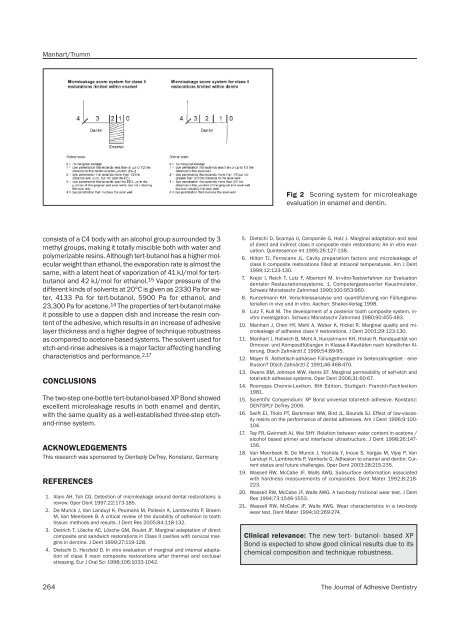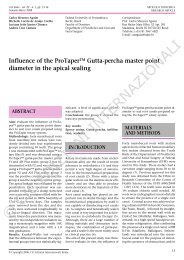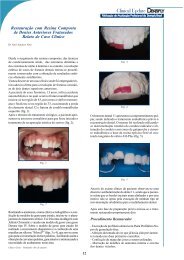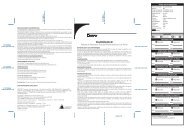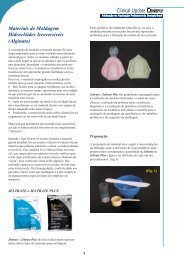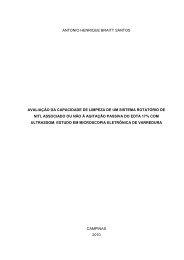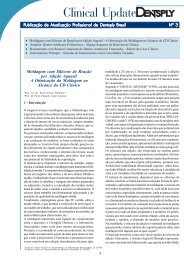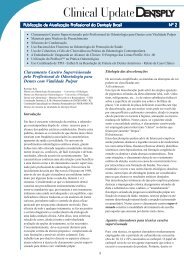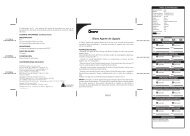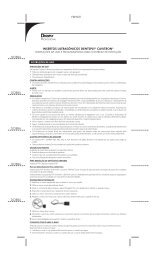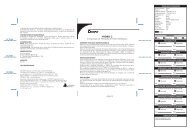You also want an ePaper? Increase the reach of your titles
YUMPU automatically turns print PDFs into web optimized ePapers that Google loves.
Manhart/Trumm<br />
Fig 2 Scoring system for microleakage<br />
evaluation in enamel and dentin.<br />
consists of a C4 body with an alcohol group surrounded by 3<br />
methyl groups, making it totally miscible both with water and<br />
polymerizable resins. Although tert-butanol has a higher molecular<br />
weight than ethanol, the evaporation rate is almost the<br />
same, with a latent heat of vaporization of 41 kJ/mol for tertbutanol<br />
and 42 kJ/mol for ethanol. 15 Vapor pressure of the<br />
different kinds of solvents at 20°C is given as 2330 Pa for water,<br />
4133 Pa for tert-butanol, 5900 Pa for ethanol, and<br />
23,300 Pa for acetone. 14 The properties of tert-butanol make<br />
it possible to use a dappen dish and increase the resin content<br />
of the adhesive, which results in an increase of adhesive<br />
layer thickness and a higher degree of technique robustness<br />
as compared to acetone-based systems. The solvent used for<br />
etch-and-rinse adhesives is a major factor affecting handling<br />
characteristics and performance. 2,17<br />
CONCLUSIONS<br />
The two-step one-bottle tert-butanol-based XP Bond showed<br />
excellent microleakage results in both enamel and dentin,<br />
with the same quality as a well-established three-step etchand-rinse<br />
system.<br />
ACKNOWLEDGEMENTS<br />
This research was sponsored by <strong>Dentsply</strong> DeTrey, Konstanz, Germany<br />
.<br />
REFERENCES<br />
1. Alani AH, Toh CG. Detection of microleakage around dental restorations: a<br />
review. Oper Dent 1997;22:173-185.<br />
2. De Munck J, Van Landuyt K, Peumans M, Poitevin A, Lambrechts P, Braem<br />
M, Van Meerbeek B. A critical review of the durability of adhesion to tooth<br />
tissue: methods and results. J Dent Res 2005;84:118-132.<br />
3. Dietrich T, Lösche AC, Lösche GM, Roulet JF. Marginal adaptation of direct<br />
composite and sandwich restorations in Class II cavities with cervical margins<br />
in dentine. J Dent 1999;27:119-128.<br />
4. Dietschi D, Herzfeld D. In vitro evaluation of marginal and internal adaptation<br />
of class II resin composite restorations after thermal and occlusal<br />
stressing. Eur J Oral Sci 1998;106:1033-1042.<br />
5. Dietschi D, Scampa U, Campanile G, Holz J. Marginal adaptation and seal<br />
of direct and indirect class II composite resin restorations: An in vitro evaluation.<br />
Quintessence Int 1995;26:127-138.<br />
6. Hilton TJ, Ferracane JL. Cavity preparation factors and microleakage of<br />
class II composite restorations filled at intraoral temperatures. Am J Dent<br />
1999;12:123-130.<br />
7. Krejci I, Reich T, Lutz F, Albertoni M. In-vitro-Testverfahren zur Evaluation<br />
dentaler Restaurationssysteme. 1. Computergesteuerter Kausimulator.<br />
Schweiz Monatsschr Zahnmed 1990;100:953-960.<br />
8. Kunzelmann KH. Verschleissanalyse und -quantifizierung von Füllungsmaterialien<br />
in vivo und in vitro. Aachen: Shaker-Verlag 1998.<br />
9. Lutz F, Kull M. The development of a posterior tooth composite system, invitro<br />
investigation. Schweiz Monatsschr Zahnmed 1980;90:455-483.<br />
10. Manhart J, Chen HY, Mehl A, Weber K, Hickel R. Marginal quality and microleakage<br />
of adhesive class V restorations. J Dent 2001;29:123-130.<br />
11. Manhart J, Hollwich B, Mehl A, Kunzelmann KH, Hickel R. Randqualität von<br />
Ormocer- und Kompositfüllungen in Klasse-II-Kavitäten nach künstlicher Alterung.<br />
Dtsch Zahnärztl Z 1999;54:89-95.<br />
12. Mayer R. Ästhetisch-adhäsive Füllungstherapie im Seitenzahngebiet - eine<br />
Illusion Dtsch Zahnärztl Z 1991;46:468-470.<br />
13. Owens BM, Johnson WW, Harris EF. Marginal permeability of self-etch and<br />
total-etch adhesive systems. Oper Dent 2006;31:60-67.<br />
14. Roempps Chemie-Lexikon. 8th Edition, Stuttgart: Franckh-Fachlexikon<br />
1981.<br />
15. Scientific Compendium: XP Bond universal total-etch adhesive. Konstanz:<br />
DENTSPLY DeTrey 2006.<br />
16. Swift EJ, Triolo PT, Barkmeier WW, Bird JL, Bounds SJ. Effect of low-viscosity<br />
resins on the performance of dental adhesives. Am J Dent 1996;9:100-<br />
104.<br />
17. Tay FR, Gwinnett AJ, Wei SHY. Relation between water content in acetone /<br />
alcohol based primer and interfacial ultrastructure. J Dent 1998;26:147-<br />
156.<br />
18. Van Meerbeek B, De Munck J, Yoshida Y, Inoue S, Vargas M, Vijay P, Van<br />
Landuyt K, Lambrechts P, Vanherle G. Adhesion to enamel and dentin: Current<br />
status and future challenges. Oper Dent 2003;28:215-235.<br />
19. Wassell RW, McCabe JF, Walls AWG. Subsurface deformation associated<br />
with hardness measurements of composites. Dent Mater 1992;8:218-<br />
223.<br />
20. Wassell RW, McCabe JF, Walls AWG. A two-body frictional wear test. J Dent<br />
Res 1994;73:1546-1553.<br />
21. Wassell RW, McCabe JF, Walls AWG. Wear characteristics in a two-body<br />
wear test. Dent Mater 1994;10:269-274.<br />
Clinical relevance: The new tert- butanol- based XP<br />
Bond is expected to show good clinical results due to its<br />
chemical composition and technique robustness.<br />
264 The Journal of Adhesive Dentistry


